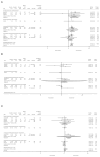The Effect of Weight Loss Before In Vitro Fertilization on Reproductive Outcomes in Women With Obesity : A Systematic Review and Meta-analysis
- PMID: 40789178
- PMCID: PMC7618032
- DOI: 10.7326/ANNALS-24-01025
The Effect of Weight Loss Before In Vitro Fertilization on Reproductive Outcomes in Women With Obesity : A Systematic Review and Meta-analysis
Abstract
Background: It is unclear whether weight loss before in vitro fertilization (IVF) improves reproductive outcomes in women with obesity.
Purpose: To assess whether weight loss interventions before IVF improve reproductive outcomes.
Data sources: Five electronic databases through 27 May 2025.
Study selection: Randomized controlled trials (RCTs) in women with obesity who were offered a weight loss intervention before planned IVF.
Data extraction: Dual independent screening, data extraction, and assessment of risk of bias (RoB) and certainty of evidence. Primary outcomes were pregnancy and live birth rates. Where appropriate, studies were pooled using random-effects meta-analyses.
Data synthesis: Twelve RCTs (1921 randomly assigned participants) were included, 7 of which had high RoB. There was moderate certainty that pre-IVF weight loss interventions were associated with an increase in total pregnancy rates (risk ratio [RR], 1.21 [95% CI, 1.02 to 1.44]; 11 studies) and pregnancies resulting from unassisted conception (RR, 1.47 [CI, 1.26 to 1.73]; 10 studies), whereas the effect on pregnancies resulting solely from IVF was uncertain. Weight loss interventions were not associated with pregnancy loss rates (RR, 1.05 [CI, 0.98 to 1.13]; 8 studies; moderate certainty), but their effect on live birth rates was unclear (RR, 1.15 [CI, 0.95 to 1.40]; 9 studies; very low certainty).
Limitations: Studies were small, had high RoB, and often did not report important outcomes, such as live births. Substantial clinical and methodological heterogeneity was unexplained by exploratory analyses.
Conclusion: Weight loss interventions before IVF appear to increase the chances of pregnancy, especially unassisted conceptions. However, studies were small, and heterogeneity made it difficult to determine the benefit of any particular intervention.
Primary funding source: National Institute for Health and Care Research Applied Research Collaboration Oxford and Thames Valley. (PROSPERO: CRD42023441457).
Conflict of interest statement
Figures

References
Publication types
MeSH terms
Grants and funding
LinkOut - more resources
Full Text Sources
Medical
